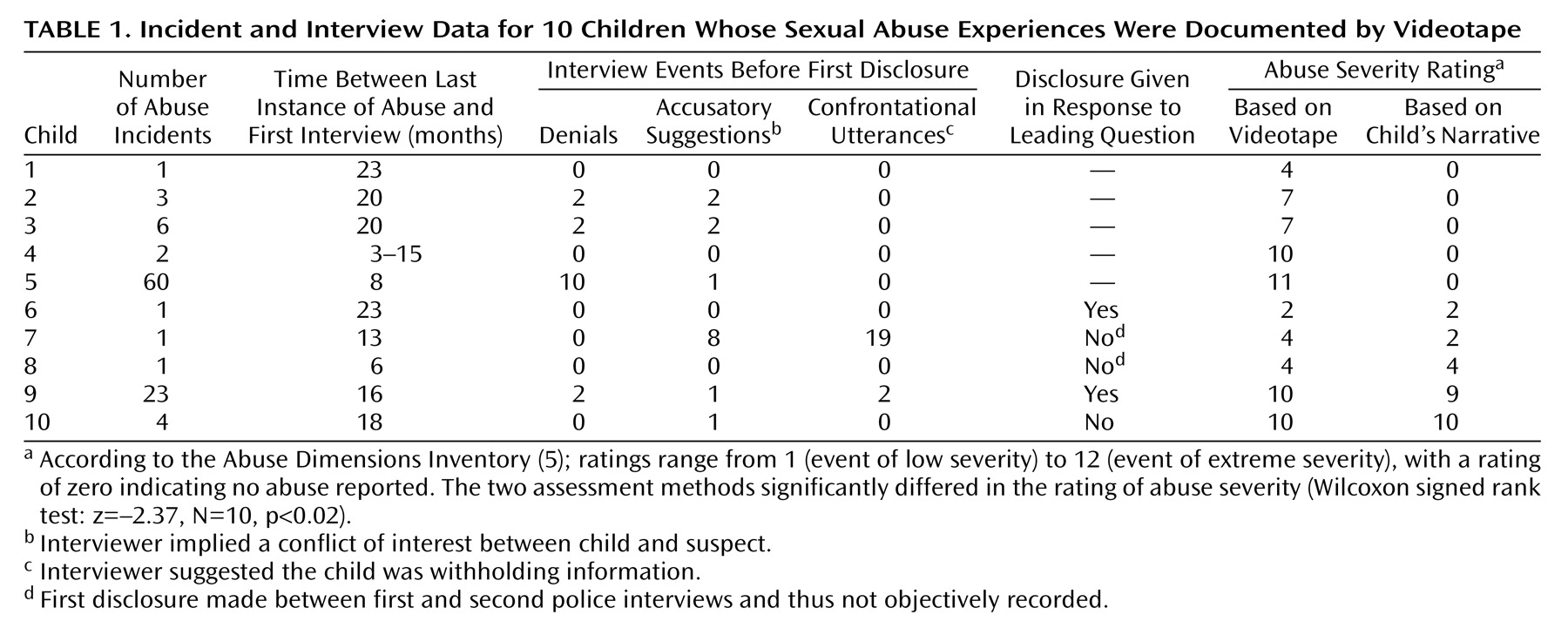Empirical studies suggest that sexually abused children may deny or only reluctantly disclose their experiences
(1,
2); the explanation for this is currently subject to controversy
(3,
4).
The aim of this study was to investigate to what extent children who were sexually abused would disclose information about their experiences as well as to describe obstacles to such disclosure. We observed police interviews of 10 children who had been sexually abused by the same man on a total of 102 occasions. Videotapes of the abuse were found by police in the home of the suspect. The man was known to the victims either by being related or by working at their day care centers. The perpetrator was detained, and two of the children (stepchildren of the perpetrator) were placed in foster care during the investigation. No child had disclosed abuse before the police investigation.
The perpetrator was 13–14 years old at the time of the first incident and 18–21 years old during the remaining ones. Abuse ranged in severity from exposing children’s genitals to oral/anal/vaginal intercourse and forced urination/defecation. He was convicted on numerous charges of child sexual abuse as well as illegal Internet distribution of some 47,000 pictures and 800 films featuring child pornography. He was sentenced to psychiatric care. The videotapes used in this study were most likely not distributed to others.
Method
The victims were nine boys and one girl. Their mean age was 5.6 years (SD=2.4) at the last instance of abuse and 6.9 years (SD=2.4) at the time of the police interview.
Videotapes of all instances of abuse (N=103) and police protocols describing all forensic child interviews (N=12) were studied. We had no influence on how the interviews were performed. This study was approved by the regional ethical committee of Karolinska Institutet and the police department conducting the investigation.
Severity of sexual abuse was rated by using the Abuse Dimensions Inventory
(5). This tool is based on the opinions of some 200 child abuse specialists and has agreeable psychometric properties
(5). The sexual abuse severity dimension ranges from 1 to 12 with “x” given when abuse is unknown. Relevant categories in our study ranged from 1 (sexually suggestive talk, hugs, or kissing) to 11 (paraphilic sex [involving urine, feces, or bondage) or exploitation [e.g., prostitution]). Nonreporting was coded as zero. Separate ratings were given for abuse severity as witnessed on the videotape and as narrated by the children.
For each interview, we identified the first abuse-related detail given by the child. We also noted the occurrence of any of the following:
1. Denial of sexual abuse memories.
2. “Accusatory suggestions” made by the interviewer, implying a conflict of interest between child and suspect.
3. “Confrontational utterances” made by the interviewer, suggesting that the child was purposefully withholding information.
We also noted whether the first detail was given in response to a leading question (option-posing or suggestive interventions), following definitions specified elsewhere
(6).
Cohen’s kappa for this coding scheme as applied independently by the authors was 0.77 on a sample of three interviews.
The children’s own comments about their communication concerning abuse were categorized after open coding.
Results
Features of abuse experiences and interviews are given in
Table 1. A two-tailed Wilcoxon signed rank test was used to compare the ratings of abuse severity based on the children’s narrative (mean score=2.7, SD=3.8) with those based on viewing the incidents on videotape (mean score=6.9, SD=3.3). The difference between these two measures was statistically significant.
No child reported sexual abuse behavior not documented on video. Three children described other forms of maltreatment for which there was no corroborative evidence.
Three disclosing children and one nondisclosing child stated that they did not want to tell. Two of them gave no specific reason, the other two presented different motives for not wanting to tell; one of them disclosed only after an option-posing intervention (“Has someone told you that you’re not allowed to tell me?”). One of the four who did not want to tell also presented as important a lack of motive for telling.
Three disclosing children stated that they had difficulties remembering all or part of the investigated incidents. Two of them said that they had actively tried to forget the events and had avoided thinking about them. Mechanisms of “common forgetting” and childhood amnesia were present in the third child, who was unable to recount certain aspects of the abuse, such as when and how it started.
Another mechanism seen in one child that complicated disclosure was a lack of adequate concepts for understanding what happened and for communicating about it.
Discussion
Despite the use of confrontational utterances, leading questions, and accusatory suggestions, there was a significant tendency of the abused children to deny or belittle their experiences. There was also an absence of false claims of sexual abuse.
Diverse reasons have been suggested as explanations for children not disclosing sexual abuse experiences
(4,
7–
10), such as a lack of understanding for the abusive aspects of an event, emotional motives (e.g., as part of a “child sexual abuse accommodation syndrome,” as suggested by Summit
[10]), childhood amnesia, and active attempts to forget or avoid abuse-related memories that lead to impaired recall. All of these factors were mentioned by children in the present study.
It is of interest that none of these descriptions suggest the existence of special memory mechanisms for trauma or child sexual abuse, although some of them (e.g., emotional motives and active attempts to forget) might be of particular importance in this context.
Our group of children was not randomly selected. Conclusions regarding prevalence of false denials of abuse in a general population and the mechanisms behind such denials in the average case cannot be drawn on the basis of this report.
Our study suggests that failure by children to disclose their experiences of sexual abuse might have diverse motivational and cognitive explanations. It furthermore suggests that professionals will never be able to identify through children’s narratives all victims of sexual abuse.


